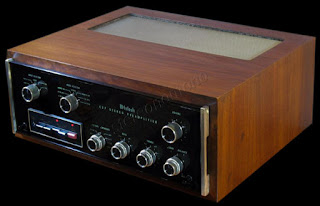McIntosh
model C 27 preamplifier features:
You Choose
From Seven Different Program Sources.
The input switch selects from five different sources or you can choose
to listen to either of two tape recorders at the push of a button.
You Always
Get The Ideal Stereo Image. The McIntosh seven position mode selector has
facilities to permit the proper balancing of a stereo system to maximize stereo
imaging. It assists in easily restoring proper stereo perspective should you
play an improperly made recording.
Tape
Recording and Playback Made Easy. Tape input, tape output and switching
facilities are provided for two three-head tape recorders. Simply push a button
to listen to either one - or record from any selected source on either or both
- or - copy from one tape recorder to another while listening to an entirely
different program. You can instantaneously monitor either tape recorder.
Listen To
Your Quiet records, Quietly. Any unwanted noise (hiss, rumble, fry, etc.) can
be reduced with the four position filter switch. It alows the removal of low
frequency noise, high frequency noise or both yet retaining as much of the
wanted program as possible.
Control
Remote Loudspeakers From Your Preamplifier. Through a unique McIntosh design,
interconnecting the preamplifier and power amplifier, you have On/Off control
of two separate sets of stereo speakers. Another advantage of this unique
design is the ability to plug your headphones into a front panel jack for
private listening.
Stepped Tone
Controls Independent In Each Channel> settings are precise and repeatable in
each channel, independently. Each tone control is a separate eleven position
switch concentrically mounted. Each step is connected to carefully selected
resistors and capacitors to give the precise frequency curve shape. Because the
tone circuit component parts are not in contact with the switch surfaces, as in
ordinary continuously variable rotary controls, they never change, never get
noisy and provide exact, repeatability settings.
You Can
Listen at Low Volumes With Equal Pleasure. A continuously variable loudness
control lets you enjoy full frequency reponse and warmth of music regardless of
the room volume you choose. As volume is reduced, the frequency response is
adjusted to complement the human ear response characteristics, the Fletcher
Munson effect.
The Constant
Loudness Balance Control. The McIntosh balance control adjust each channel
independently for proper stereo imaging without a modification of overall
stereo volume in the room. While natural balance is at the center of the
control; adjustment to either right or left compensates for program variations
or room acoustic differences.
Precision
Step Attenuator Volume Control. Ideal volume control tracking accuracy and
noise free performance are two of the considearable benefits of the McIntosh
Precision Step Attenuator. It is a thirty-two step, 70 dB range control with
unheared of tracking accuracy within 1 dB. The extreme accuracy is obtained
through special electronically controlled resistance element trimming. The
accuracy and quiet operation are maintained because the switch commutator
touches only the switch contact pad and not the precision resitor elements.
Specifications:
Frequency
Response: 20 Hz - 20 kHz (+0 -0,5 dB)
Harmonic
Distortion: will not exceed 0,05% (at
rated output 20Hz-20kHz)
Hum and
Noise:
Phono 1, 2
: 80 dB below 10 mV input (unweighted);
85 dB IHFA (weighted)
Tuner, Aux,
Tape 1,2 : 85 dB (unweighted); 90 dB IHF
A(weighted)
Input
Sensitivity/Impedance:
Phono 1, 2
: 2 mV/47 k Ω and 100pF
Tuner, Aux,
Tape 1,2 : 250 mV/100 k Ω
Output
Level/Impedance:
Main Output
: 2,5 volts with rated input, less than
1 k Ω source impedance (max. output is greater than 10 volts)
Tape Output
: 2,5 volts with rated input, less than
1,5 k Ω source impedance (max. output is greater than 10 volts)
Center
Channel Output (L+R) : 2,5 volts with
rated input to both channels, less than 1,2 k Ω source impedance, to operate
into 22 k Ω load or higher
Voltage
Amplification In Decibels:
Phono 1, 2
: to Main Output 62 dB; to Tape Output
42 dB
Tuner, Aux
tape 1, 2 : to Main Output 20 dB; to
Tape Output 0 dB
Tone
Controls:
Bass : -17 dB to +16 dB at 20 Hz (Separate 11
position rotary switches for each channel)
Treble
: -20 dB to +20 dB at 20 kHz (Separate
11 position rotary switches for each channel)
Filter
Switch:
Low
Frequency (Rumble Filter): Flat or
roll-off 6 dB per octave below 50 Hz, down 12 dB at 20 Hz
High
Frequency (Scratch Filter) : Flat or roll-off 6 dB per octave above 5 kHz, down
12 dB at 20 Hz
Semiconductor
Complement: 18 Silicon-Planar
transistors; 4 Silicon diodes; 5 Light Emitting diodes (LED)
AC Power
Outlets: 4 switched and 1 unswitched
(red)
Power
Requirements: 120 volts 50/60 Hz
Power
Consumption: 15 watts
Dimensions
(W x H x D):
Chassis
; 375 x 122 x 330 mm (14-3/4" x
4-13/16" x 13")
Front Panel
: 406 x 138 mm (16" x 5-7/16")
Weight:
Net : 9,1 kg (20 pounds)
Shipping
: 14,5 kg (32 pounds)
Finish: Front panel is anodized gold and black with
special McIntosh gold/teal panel nomencalture illumination. Chassis is black
Mounting: exclusive McIntosh developed professional
Panloc





Nessun commento:
Posta un commento